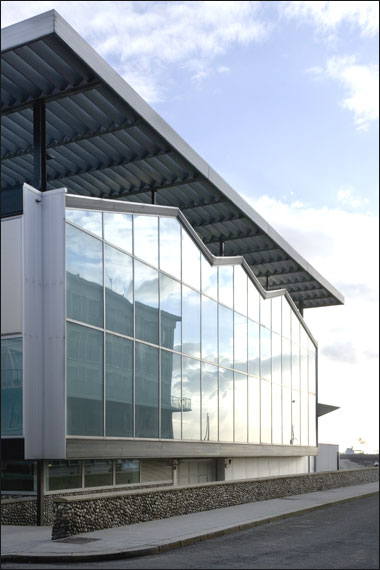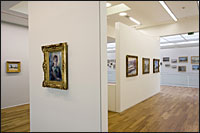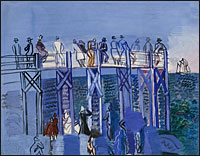Inaugurated on 24 June 1961 by André Malraux, the museum bearing his name – the first museum rebuilt in France after the war - was designed by two students of Auguste Perret, Guy Lagneau and Raymond Audigier, based on the innovating principles of flexibility and transparency. The lightness of the steel, aluminium and glass structure, as well as the suspended picture rails and the open spaces allowed the permanent movement of the collections. The enlargement of the collections and of the activities had nevertheless entailed a complete renovation in 1999. Seven years later the same team of architects has had to reorganize the disposition of a part of the mezzanine to install the Senn-Foulds donation as it deserves. The Malraux museum is now a major site for those who are interested in French art of the turn of the XIXth and XXth centuries. It opens its doors again today by presenting simultaneously what is now the second impressionist collection in France and a very original exhibition of contemporary art.
The sea is a major element of the scenography
In the mezzanine zone, previously divided into compartments in order to present the Romantic collections and Boudin’s works, the rooms proved to be poorly adapted to the presentation of luminous works such as those of the Senn-Foulds donation. The proposal made by Laurent and Emmanuelle Beaudouin, Sandra Barclay and Jean-Pierre Crousse consisted in modelling the setting up of the walls, and in placing them perpendicularly to the West façade (looking to the sea), just like on the lower floor, as to let the natural light largely penetrate the new rooms. The creation of an additional well of light contributes to this natural lighting and also creates an interesting perspective on Jean Prouvé’s lamp shade, which until now was hardly visible from the rooms. The space, turned to the light of the estuary, also gains more hanging area. One can now look from one side to the other of the building, from the large «Boudin» hanging area to the landscape at the entrance of the port, from the works to the nearby sea, as the latter now becomes a major element of the scenography. The fluidity of the visitors also favours the dialogue between the paintings and the light that saw them come to life.
A cabinet of drawings
In parallel, a cabinet of drawings has been created, in the continuity of the new Senn rooms, to present the graphic works of the donation, as well as the ones that come from historic collections, from the Boudin, Marande and Dufy donations and legacies. The paintings will be changed around each quarter and this will allow us to discover this fund, which to this day had rarely been shown. It will present the public a sampling of the collection of graphic arts from the Malraux museum that holds nearly one thousand five hundred objects. The public hardly knows this ensemble that covers a wide panorama of the history of art from the XVIIth century to our times and includes for example, works by Boucher, Valenciennes, Greuze, Géricault, Daumier, Bonington, Boudin, Pissarro, Sisley, Derain, Dufy, Foujita, Adam… The collection has just recently been enriched with one hundred and thirty drawings from the Senn-Foulds collection. In order to inaugurate this new space, the museum presents some of the pieces from the collection belonging to Charles-Auguste Marande. This is an opportunity to enhance once again the close resemblances between the Marande and the Senn collections. Charles-Auguste Marande’s strong liking for impressionism, clearly expressed in his choices in painting, continues to show in his collection of drawings, enhanced in particular with a Jongkind, a Sisley, a Pissarro, four Maufra and three Ravier
Illustration: Musée Malraux Inside view. Photo: Florian Kleinefenn
Acquisitions and exhibitions
The movement continues… Last December, the Havre acquired for the museum an exceptional ensemble of fauve ceramics by Emile-Othon Friesz, originally from a decor for the façade of a villa in Sainte-Adresse. This will be one of the major pieces of the Emile-Othon Friesz retrospective, in preparation for 2007-2008 in collaboration with the museum of Art and Industry of Roubaix and the museum of Modern Art of Céret.
Art Le Havre, the Biennial event of contemporary art, is presenting until September 4 of this year Continuum . The exhibition groups around a palindrome – a theme at the heart of the major current challenges in contemporary art – the work of artists from the international scene, from Gary Hill and Hervé Robbe to Dana Claxton or Ed Ruscha, shown through various media, in particular video, sculpture, photography and literature. The exhibition is linked to the double reading allowed by the structure of the palindrome, to its different reversals, to the dialogue that makes it possible to read it from left to right or from right to left. All this leads to thinking about the subject of a double, to contemplation or to the eternal beginning.
The collections that remain in the reserve will be presented by rotation in the temporary exhibit room, in exhibitions based on themes or chronology. A first event is already scheduled for the spring of 2007, in partnership with the FRAC Haute-Normandie (Regional Fund for Contemporary Art in High Normandy), around collections of the XXth century, and in particular those from 1945 to 1970
Illustration: Raoul Dufy, Le Havre, the pier and the beach, 1926, Donation by Madame Dufy, 1962.
:
To see more illustrations, click on VERSION FRANCAISE at the top of this page
|










